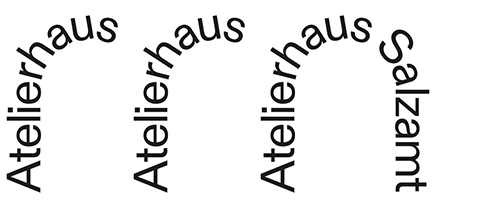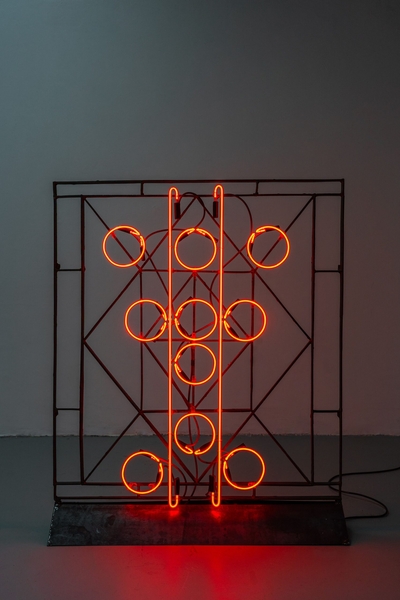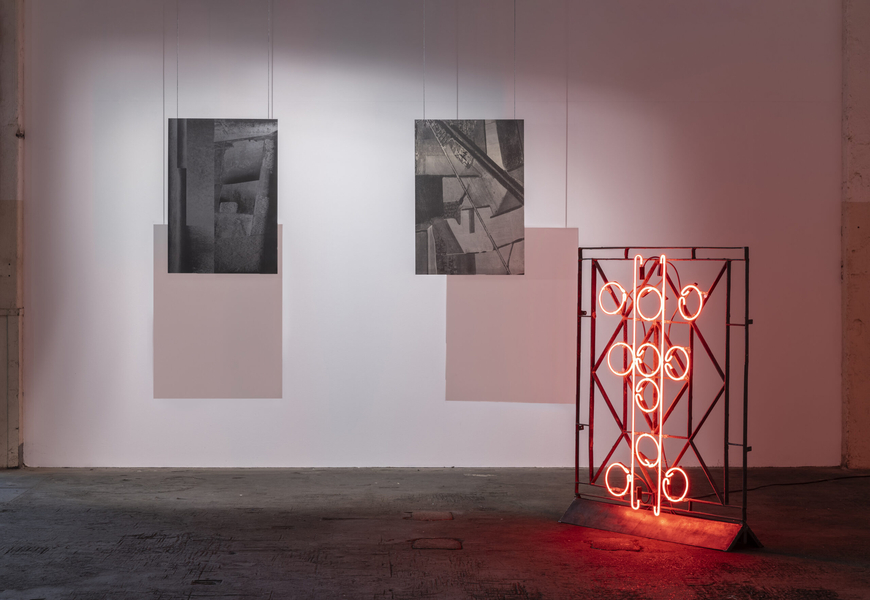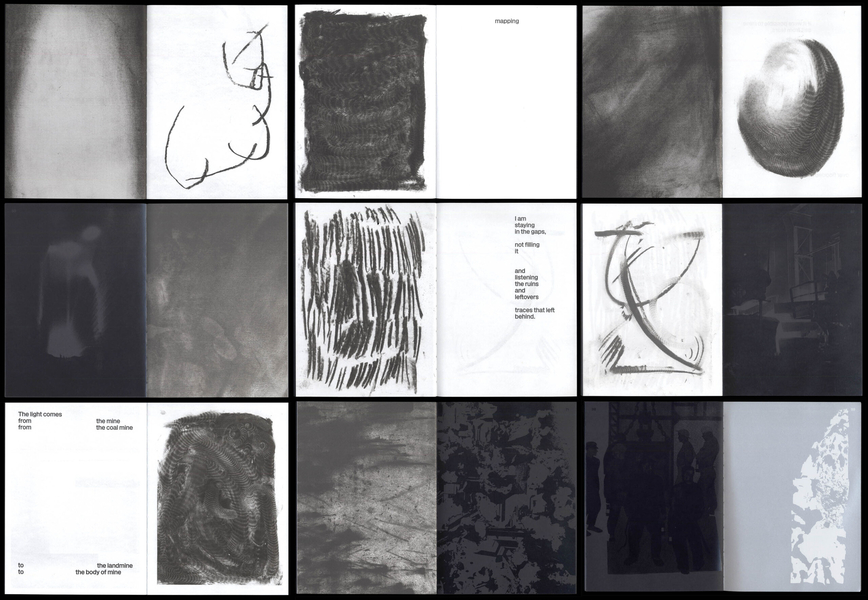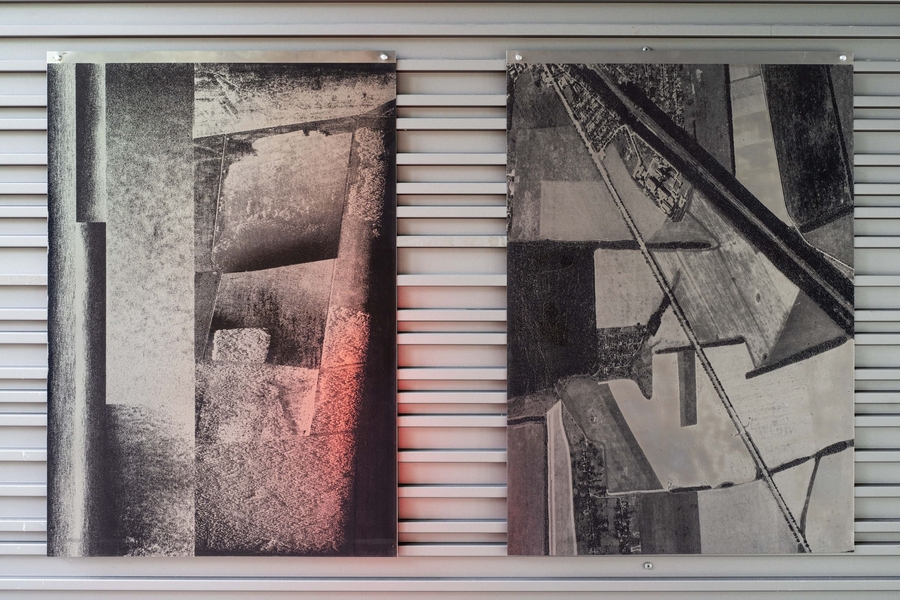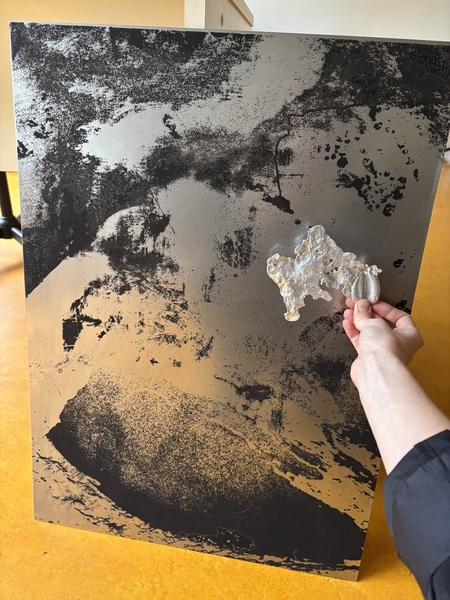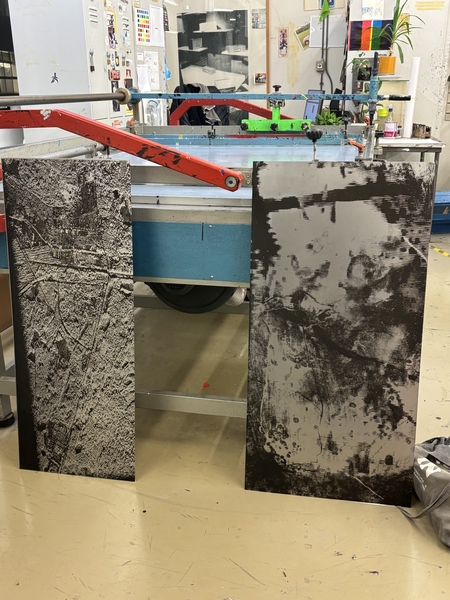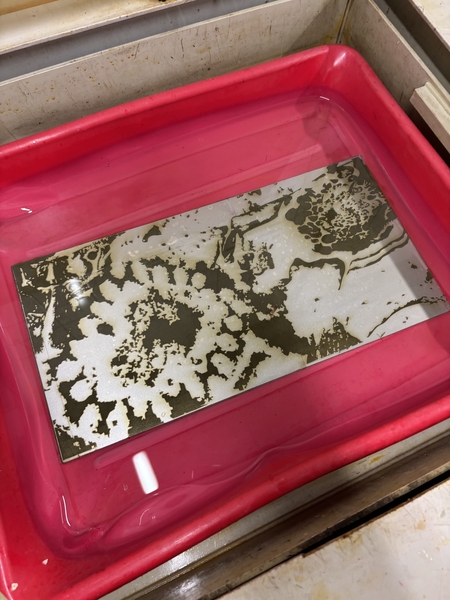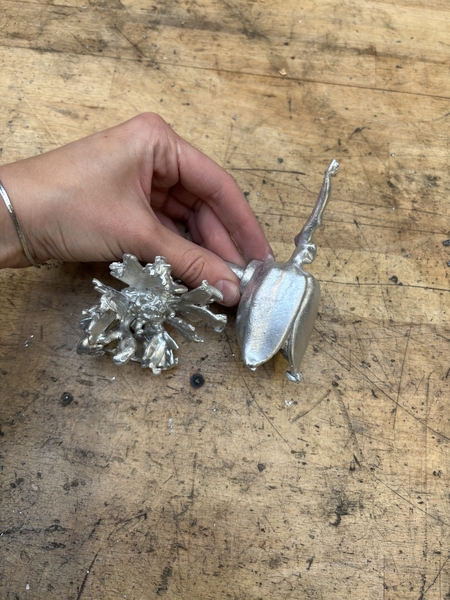Stefania Bodnia – Artist in Residence
Für die deutsche Version bitte nach unten scrollen.
How do you work?
My work operates at the intersection of art and design, being informed by my engagement with historical, anthropological and material research and personal experiences. It takes the form of publications, installations, and prints. My research-based work manifests as visual poetry and engages with the materiality of typography and graphics, used as a tool to construct narratives that address history, society and personal experience. My exploration focuses on the power dynamics between the West and East, as well as the intersection of materiality, technology, geology, and power structures. Alongside these, I carry out projects that convey a sense of urgency and political relevance, emphasised by connections and origins informed by my background.
Fotos: Stefania Bodnia
You designed the cover for Publication Society of the Frontline: A Guidebook of Kyiv Perennial. How did you choose the visual language and what did you rely on in this artwork?
For the graphic identity of the Kyiv Biennial 2023 and Perennial, Aliona Ciobanu and I chose the metaphor of metal wires and knots to symbolise transformation amidst the chaos of ongoing war. These wires transform and merge to form different knots for each new exhibition. Through visual communication, the venue intertwines fragmented experiences to create a cohesive tapestry of shared artistic expression and resilience. Like a Gordian knot that is not easy to resolve. Incidentally, Gorbachev also used knot metaphor in Reykjavik in 1986 when discussing the Cold War — a vast, tangled web of nuclear weapons, mistrust and ideological confrontation that seemed impossible to untie.
For the book cover of the publication Society of the Frontline: A Guidebook of Kyiv’s Perennials, I decided to keep this metaphor, but to add a reflective afterword, as this book was intended. Over time, the steel changes colour – grey turns to red rust. This complements the idea of the vibrancy of shifting frontlines and war realities, highlighting the urgency of the matter.
How has your artistic practice generally changed with the start of russia’s full-scale war in Ukraine?
The political focus emerged early in my practice due to the impossibility of separating the situation from the geopolitical context of the grey zone in eastern Ukraine where I was raised. This area was first invaded in 2014, while I was still at secondary school. There is no distinction between my body and the numerous historical processes enacted through me. My identity reflects as a witness to all the events encoded in my body and memory.
I was studying in The Hague when the invasion happened in 2022. Living abroad at a distance, I had already started to reflect on my eastern Ukrainian identity. On the first day of the invasion, we formed a student collective to immediately start collecting funds for those in need. This was a form of activism, a way of taking direct action together in times of urgency. I then learned more sophisticated tools and a research approach that allowed me to talk poetically about micro and macro traumas, ideologies, and the interweaving of narratives from social, historical, scientific and political realms.
In November, the Kyiv Biennale “Vertical Horizon” will be held at the Lentos Museum in Linz, for which you are creating an installation in collaboration with sound artist Jack Dove. In The Hague (the Netherlands), you create a work of sound metal panels with graphics of landscapes of Donetsk region (Ukraine), complemented by sculptural natural elements and metal non-human objects. In particular, you use steel, coal, ash and graphite. Please tell us about the concept of your installation? How do you symbolically combine the space of cities and countries, as well as materials and sound? What story will your artwork tell the visitors or what questions will it ask?
Like the layers of sediment peeled back during precious metal and mineral mining, war operations leave behind a perforated landscape, resulting in a porous structure with voids and encapsulated spaces within the layers of the land. This audio-visual work draws parallels between personal trauma and geotrauma, where the layers of geological formations intersect with vectors of power, embodying the violence of extractive practices and war.
The imagery combines satellite footage of the mining area in eastern Ukraine, where military operations take place above and under ground; engravings of mineral porosity, and performative drawings of landscape. These layers of representation reveal the vertical continuum connecting the subterranean and the digital realms, spanning everything from mines to the cloud.
The project gives a voice to resources, including minerals, land, non-human entities and human labour. All of these are seen as material for the operations of power. Synthesised sounds and processed samples are constructed to move and momentarily distort the metal, placing reconstructions of unspoken memory and spirit into the steel. Metal plates and sculptural elements are transformed into resonant instruments, allowing matter itself to speak.
I see the collaboration as an act of bridging. I come from a ‘borderless’ space, an area that exists between margins. For 5 years, I have been based in The Hague, where I live and work from, a city of peace and justice, located on the western coast of Europe. Jack, on the other hand, is based in London, outside the EU margins. Together, our collaboration becomes an act of bridging senses, contexts, proximities, and topics, transcending geographical boundaries to create a vibrating dialogue.
The Interview with Stefania Bodnia was recorded by Anna Gaidai, October 2025.
***
Wie arbeiten Sie?
Meine Arbeit bewegt sich an der Schnittstelle von Kunst und Design und ist geprägt von meinem Engagement für historische, anthropologische und materielle Forschung sowie persönlichen Erfahrungen. Sie manifestiert sich in Form von Publikationen, Installationen und Druckgrafiken. Meine forschungsbasierte Arbeit äußert sich als visuelle Poesie und beschäftigt sich mit der Materialität von Typografie und Grafik, die als Werkzeuge dienen, um Erzählungen zu konstruieren, die sich mit Geschichte, Gesellschaft und persönlicher Erfahrung auseinandersetzen.
Mein künstlerisches Interesse gilt den Machtverhältnissen zwischen West und Ost sowie den Schnittpunkten von Materialität, Technologie, Geologie und Machtstrukturen. Daneben realisiere ich Projekte, die ein Gefühl von Dringlichkeit und politischer Relevanz vermitteln – betont durch Bezüge und Ursprünge, die in meinem Hintergrund verwurzelt sind.
Sie haben das Cover für die Publikation Society of the Frontline: A Guidebook of Kyiv Perennial gestaltet. Wie haben Sie die visuelle Sprache gewählt und worauf haben Sie sich bei diesem Werk gestützt?
Für die grafische Identität der Kyiv Biennale 2023 und Perennial wählten Aliona Ciobanu und ich die Metapher von Metalldrähten und Knoten, um Transformation im Chaos des andauernden Krieges zu symbolisieren. Diese Drähte verwandeln sich und verbinden sich zu unterschiedlichen Knoten für jede neue Ausstellung. Durch die visuelle Kommunikation verknüpft der Ausstellungsort fragmentierte Erfahrungen zu einem zusammenhängenden Geflecht gemeinsamer künstlerischer Ausdrucksformen und Resilienz – wie ein gordischer Knoten, der sich nicht leicht lösen lässt.
Übrigens verwendete auch Gorbatschow 1986 in Reykjavik die Knotenmetapher, als er über den Kalten Krieg sprach – ein gewaltiges, verstricktes Netz aus Atomwaffen, Misstrauen und ideologischen Gegensätzen, das unmöglich zu entwirren schien.
Für das Buchcover der Publikation Society of the Frontline: A Guidebook of Kyiv’s Perennials entschied ich mich, diese Metapher beizubehalten, sie aber mit einem reflektierenden Nachwort zu versehen, wie es für dieses Buch vorgesehen war. Mit der Zeit verändert Stahl seine Farbe – das Grau wird zu rotem Rost. Das ergänzt die Idee von der Lebendigkeit sich verschiebender Frontlinien und Kriegsrealitäten und unterstreicht die Dringlichkeit des Themas.
Wie hat sich Ihre künstlerische Praxis mit dem Beginn des russischen Großangriffs auf die Ukraine verändert?
Der politische Fokus entstand schon früh in meiner Praxis, da es unmöglich war, die eigene Situation vom geopolitischen Kontext der „Grauzone“ im Osten der Ukraine zu trennen, in der ich aufgewachsen bin. Dieses Gebiet wurde 2014 zum ersten Mal besetzt, während ich noch zur Schule ging. Es gibt keine Trennung zwischen meinem Körper und den zahlreichen historischen Prozessen, die sich durch mich vollziehen. Meine Identität spiegelt sich als Zeugnis all jener Ereignisse wider, die in meinem Körper und meiner Erinnerung eingeschrieben sind.
Als die Invasion 2022 begann, studierte ich in Den Haag. Das Leben im Ausland, auf Distanz, hatte mich bereits dazu gebracht, über meine ostukrainische Identität nachzudenken. Am ersten Tag der Invasion gründeten wir ein Studierendenkollektiv, um sofort Spenden für Bedürftige zu sammeln. Das war eine Form des Aktivismus – ein Weg, gemeinsam in Zeiten der Dringlichkeit direkt zu handeln.
Später lernte ich differenziertere Werkzeuge und eine forschende Herangehensweise kennen, die es mir ermöglichten, poetisch über Mikro- und Makrotraumata, Ideologien und das Ineinandergreifen von Erzählungen aus sozialen, historischen, wissenschaftlichen und politischen Bereichen zu sprechen.
Im November findet im Lentos Kunstmuseum Linz die Kyiv Biennale Vertical Horizon statt, für die Sie gemeinsam mit dem Soundkünstler Jack Dove eine Installation schaffen. In Den Haag (Niederlande) entwickeln Sie eine Arbeit aus metallischen Klangplatten mit grafischen Darstellungen von Landschaften der Region Donezk (Ukraine), ergänzt durch skulpturale Naturelemente und metallene nicht-menschliche Objekte. Sie verwenden insbesondere Stahl, Kohle, Asche und Graphit.
Bitte erzählen Sie uns vom Konzept Ihrer Installation. Wie verbinden Sie symbolisch die Räume von Städten und Ländern sowie Materialien und Klang? Welche Geschichte wird Ihr Werk den Besucher*innen erzählen oder welche Fragen wird es aufwerfen?
Wie die Sedimentschichten, die bei der Förderung von Edelmetallen und Mineralien freigelegt werden, hinterlässt der Krieg eine perforierte Landschaft – eine poröse Struktur mit Hohlräumen und eingeschlossenen Räumen in den Schichten des Bodens.
Diese audiovisuelle Arbeit zieht Parallelen zwischen persönlichem Trauma und Geotrauma, bei denen sich die Schichten geologischer Formationen mit Machtvektoren überschneiden und die Gewalt extraktiver Praktiken und des Krieges verkörpern.
Das Bildmaterial kombiniert Satellitenaufnahmen des Bergbaugebiets im Osten der Ukraine – dort, wo militärische Operationen über und unter der Erde stattfinden – mit Gravuren mineralischer Porosität und performativen Landschaftszeichnungen. Diese Darstellungsschichten offenbaren ein vertikales Kontinuum, das die unterirdischen und digitalen Bereiche miteinander verbindet – von den Minen bis zur Cloud.
Das Projekt verleiht Ressourcen eine Stimme – Mineralien, Land, nicht-menschlichen Entitäten und menschlicher Arbeit. All dies wird als Material für Machtoperationen betrachtet.
Synthesiser-Klänge und bearbeitete Klangproben werden so konstruiert, dass sie sich bewegen und das Metall kurzzeitig verformen – als würden unausgesprochene Erinnerungen und Geister in den Stahl eingeschrieben. Metallplatten und skulpturale Elemente werden zu Resonanzinstrumenten, die der Materie selbst eine Stimme verleihen.
Ich betrachte die Zusammenarbeit als einen Akt des Brückenschlags. Ich komme aus einem „grenzenlosen“ Raum, einem Gebiet, das zwischen den Rändern existiert. Seit fünf Jahren lebe und arbeite ich in Den Haag – einer Stadt des Friedens und der Gerechtigkeit an der westlichen Küste Europas. Jack hingegen lebt in London, außerhalb der Grenzen der EU.
Gemeinsam wird unsere Zusammenarbeit zu einem Akt des Verbindens von Sinneseindrücken, Kontexten, Distanzen und Themen – sie überschreitet geografische Grenzen und schafft einen vibrierenden Dialog.
Das Interview mit Stefania Bodnia führte Anna Gaidai, Oktober 2025.
